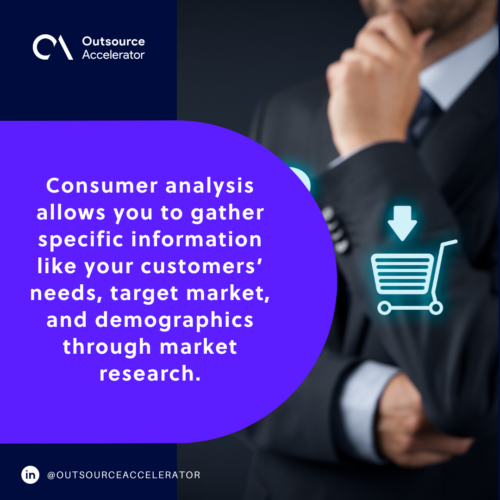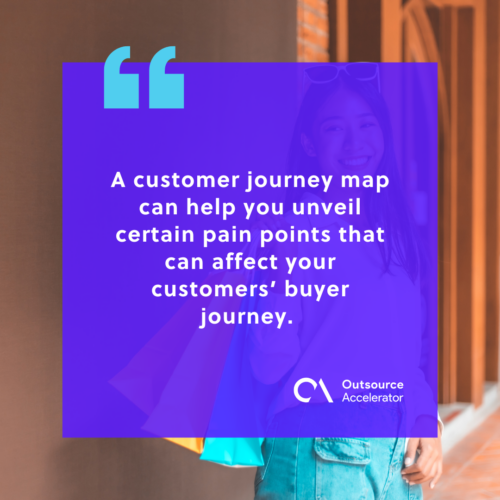Defining consumer analysis: Find out what it brings to your business

How your business progresses will hugely depend on how well you know your target market and consumers. You need to have a business plan. Thus, having an in-depth understanding of your customers is one crucial component of the effectiveness of your business plan.
The success of your business will also depend on how well your customers will patronize your brand. Without these consumers, you won’t be able to sell your products and services. More so, without sales, you won’t be able to earn a profit.
In this article, we’ll talk about the fundamentals of consumer analysis and how it will benefit your business. We’ll also be discussing the steps to an effective consumer analysis process.
What is consumer analysis?
According to a KPMG survey, 81% of businesses rely on analytics to have a deeper understanding of who their customers are.
Consumer analysis allows you to gather specific information like your customers’ needs, target market, and demographics through market research. It is also used in determining your customer’s pain points, their overall customer experience, and in predicting consumer behavior.
The results you get from your consumer analysis will be a significant factor in how you will be reaching out to your target market.

Effective steps in the consumer analysis process
Now, let’s walk you through the steps you can take in starting your consumer analysis process:
Segmenting your customer database
Start with your existing customer database. Group your database according to customers with the same characteristics. This process is called segmentation.
In this first step, customers are usually divided according to demographic, psychographic, geographic, behavioral, technographic, value-based, needs-based, business size, and industry.
Segmentation enables you to sort your customers into groups and create marketing strategies for each of them.
Determine your most valuable customers
Next, it is important to distinguish your most valuable customers. As stated in the Pareto Principle, 80% of every organization comes from 20% of customers.
This is highly applicable to most companies as it is critical to have a good understanding of your customers first before proceeding to the other 80%.
To help you identify your most valuable customers, you need to look for patterns on your database and follow specific customer metrics.
Engage with your customers
Data is not enough to know your customers better, you need to talk to them to get into their heads.
Reach out to your customers to help you understand their wants, needs, pain points, and emotions. Note that 95% of people’s purchase decisions are all based on their emotions.
Collect customer feedback
As you talk to your customers, you should also collect unbiased opinions regarding your products and services. You can do this by interacting with your customers on social media, chatting, and going through review pages.
You can also make use of sentiment analysis tools to help you measure your customers’ outlooks and tone.
Survey execution
Besides interacting and collecting your customers’ feedback, you should also consider running surveys. The two prior steps allow you to know your customers’ concerns and motivations; these are all merely hypotheses.
A survey will then confirm or refute these hypotheses. You can choose to perform an in-app survey, post-service survey, or long email survey.
Create customer personas
Your customers will buy your products and services for their specific reasons. Use all your gathered data to create customer personas of your target consumers.
These customer personas will serve as the stereotypes of your target customer base.
Start your customer journey map
Once you’ve executed your consumer analysis, you need to evaluate all collected data so you can identify patterns and similar themes.
Remember that your customers will behave differently at every stage of their buyer’s journey. A customer journey map will give you insights as to what factors can make or break their experience.
A customer journey map can help you unveil certain pain points that can affect your customers’ buyer journey. More so, it serves as a representation of your customers’ touchpoints as they go through their customer journey.

Consumer analysis supports these areas in your business
Effective consumer analysis can help you especially in these areas of your business:
Sales
You can also utilize consumer analysis to help you determine specific factors that can have a positive and negative impact on your sales.
Having a deeper understanding of your customers’ purchasing decisions is one major key in boosting your sales.
Customer retention
Customer acquisition can be pricey. Consumer analysis lets you uncover the reasons why your customers leave.
More so, it can also give you early warning signs about your customers’ possibility of leaving if you don’t act on it.
Marketing efforts
Consumer analysis will also be a significant part of your marketing efforts. Knowing who your target customers are can help you market your products and services more effectively.
It will also give you insights as to what marketing channels will bring you added value to customers and close more deals. Moreover, you can save on your marketing costs, at the same time widen your reach.
The more you know and understand your target consumers, the more you can meet their needs and demands.







 Independent
Independent




